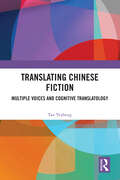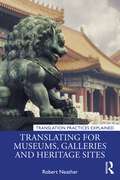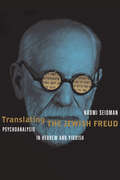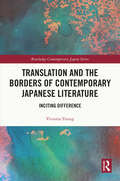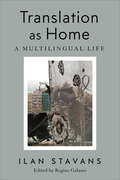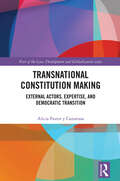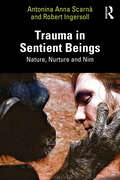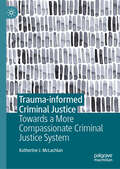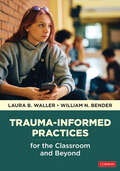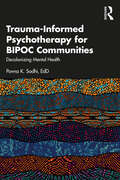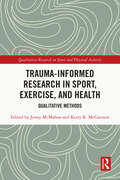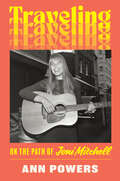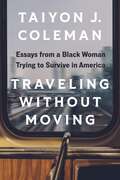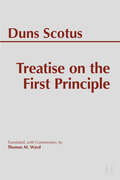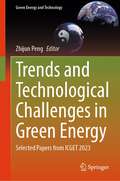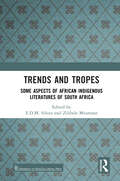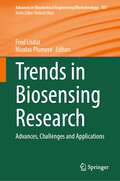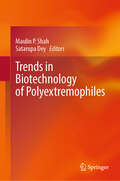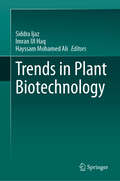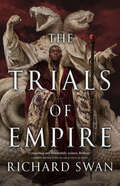- Table View
- List View
Translating Chinese Fiction: Multiple Voices and Cognitive Translatology
by Tan YeshengDrawing on the cognitive translatological paradigm, this book introduces a situation-embedded cognitive construction model of translation and explores the thinking portfolios of British and American sinologists-cum-translators to re-examine their multiple voices and cognition in translating Chinese fiction.By placing sinologists-cum-translators in the same discourse space, the study transcends the limitations of previous case studies and offers a comprehensive cognitive panorama of how Chinese novels are rendered. The author explores the challenges and difficulties of translating Chinese fiction from the insider perspectives of British and American sinologists, and cross-validates their multiple voices by aligning them with cross-cultural communication scenarios. Based on the cognitive construction model of translation, the book provides a systematic review of the translation thoughts and ideas of the community of sinologists in terms of linguistic conventions, narrative styles, contextual and cultural frames, readership categories and metaphorical models of translation. It envisions a new research path to enhance empirical research on translators' cognition in a dynamic translation ecosystem. The title will be an essential read for students and scholars of translation studies and Chinese studies. It will also appeal to translators and researchers interested in cognitive stylistics, literary studies and intercultural communication studies.
Translating for Museums, Galleries and Heritage Sites (Translation Practices Explained)
by Robert NeatherIn any museum, gallery, or heritage site that wishes to engage with foreign-language visitors, translation is essential. Providing texts in foreign languages – whether for international visitors from different language cultures or for heritage speakers of local minority languages – is centrally important in enabling these visitors to make sense of what they see displayed. Yet despite this awareness, and a growing body of research in the field, there has hitherto been little available in the way of practical training in this area of translation. This book aims to help fill that need.Translating for Museums, Galleries and Heritage Sites focuses on the translation of interpretive and information texts, particularly in the museum context. After an initial introduction and an overview of key concepts in both museums and translation, it looks at three broad groupings of texts from the museum text system: fixed labels and wall panels, leaflets and other portable learning resources, and catalogues and guides, including a section on websites. It concludes with a call to place translation centre stage in museum, gallery, and heritage practice. The book will be of use as a coursebook for students at both undergraduate and postgraduate levels, and for practitioners in the sector, and is designed to be suitable for both individual and class-based learning.
Translating the Jewish Freud: Psychoanalysis in Hebrew and Yiddish (Stanford Studies in Jewish History and Culture)
by Naomi SeidmanThere is an academic cottage industry on the "Jewish Freud," aiming to detect Jewish influences on Freud, his own feelings about being Jewish, and suppressed traces of Jewishness in his thought. This book takes a different approach, turning its gaze not on Freud but rather on those who seek out his concealed Jewishness. What is it that propels the scholarly aim to show Freud in a Jewish light? Naomi Seidman explores attempts to "touch" Freud (and other famous Jews) through Jewish languages, seeking out his Hebrew name or evidence that he knew some Yiddish. Tracing a history of this drive to bring Freud into Jewish range, Seidman also charts Freud's responses to (and jokes about) this desire. More specifically, she reads the reception and translation of Freud in Hebrew and Yiddish as instances of the desire to touch, feel, "rescue," and connect with the famous Professor from Vienna.
Translation and the Borders of Contemporary Japanese Literature: Inciting Difference (Routledge Contemporary Japan Series)
by Victoria YoungThis book examines contemporary debates on such concepts as national literature, world literature, and the relationship each of these to translation, from the perspective of modern Japanese fiction.By reading between the gaps and revealing tensions and blind spots in the image that Japanese literature presents to the world, the author brings together a series of essays and works of fiction that are normally kept separate in distinct subgenres, such as Okinawan literature, zainichi literature written by ethnic Koreans, and other “trans-border” works. The act of translation is reimagined in figurative, expanded, and even disruptive ways with a focus on marginal spaces and trans-border movements. The result decentres the common image of Japanese literature while creating connections to wider questions of multilingualism, decolonisation, historical revisionism, and trauma that are so central to contemporary literary studies.This book will be of interest to all those who study modern Japan and Japanese literature, as well as those working in the wider field of translation studies, as it subjects the concept of world literature to searching analysis.
Translation as Home: A Multilingual Life
by Ilan StavansTranslation as Home is a collection of autobiographical essays by Ilan Stavans that eloquently and unequivocally make the case that translation is not only a career, but a way of life. Born in Mexico City, Ilan Stavans is an essayist, anthologist, literary scholar, translator, and editor. Stavans has changed languages at various points in his life: from Yiddish to Spanish to Hebrew and English. A controversial public intellectual, he is the world’s authority on hybrid languages and on the history of dictionaries. His influential studies on Spanglish have redefined many fields of study, and he has become an international authority on translation as a mechanism of survival. This collection deals with Stavans’s three selves: Mexican, Jewish, and American. The volume presents his recent essays, some previously unpublished, addressing the themes of language, identity, and translation and emphasizing his work in Latin American and Jewish studies. It also features conversations between Stavans and writers, educators, and translators, including Regina Galasso, the author of the introduction and editor of the volume.
Transnational Constitution Making: External Actors, Expertise, and Democratic Transition (Law, Development and Globalization)
by Alicia Pastor y CamarasaThis book examines the largely neglected but crucial role of transnational actors in democratic constitution-making.The writing or rewriting of constitutions is usually a key moment in democratic transitions. But how exactly does this take place? Most contemporary comparative constitutional literature draws on the concept of constituent power – the power of the people – to address this moment. But what this overlooks, this book argues, is the important role of external, transnational actors who tend to play a crucial role in the process. Drawing on sociolegal methodologies but informed by new legal realism, this book develops a new theoretical framework for examining the involvement of such actors in constitution-making. Empirically grounded, the book uncovers a more comprehensive picture of how constitution-making unfolds on the ground. Illuminating the power dynamics at play during the legal process, it reveals not only the wide range of external actors involved but also the continuity between decolonisation and post-Cold War constitution-making. This book, the first to provide an in-depth examination of external actor involvement in constitution-making, will appeal to scholars of constitutional law, sociolegal studies, law and development, and transitional justice.
Trauma in Sentient Beings: Nature, Nurture and Nim
by Robert Ingersoll Antonina Anna ScarnàThis is a book about the bond between sentient beings. It explores the non-verbal space between two entities, and asks questions like: What is a healthy human being? Is it nature? Nurture? Nature via nurture? How are we born with personality traits, emotion, mood, language abilities, and intelligence? What do we know about attachment, family structure, and genetic inheritance?Dr Anna Scarnà and Robert Ingersoll use the life history of the chimpanzee, Nim Chimpsky and his family: parents Carolyn and Pan, companion Lilly, their daughter, Sheba, and an assortment of human carers, to explain the hallmarks of healthy human psychological development. What makes humans "human", and chimpanzees, "chimpanzees"? Do chimpanzees have a personality, or should we consider them to have a “chimpanality?”Robert, close friend and carer of Nim, gives the facts about Nim’s upbringing and first-degree relatives, and Anna reports with reference to theories of brain, personality, self, and language. Together they explain what can be drawn from psychological research and reanalyse the chimpanzee work from the 1960s and 1970s in order to honour and respect the memory of those animals.
Trauma-informed Criminal Justice: Towards a More Compassionate Criminal Justice System
by Katherine J. McLachlanThis book is the first to examine trauma-informed criminal justice responses to the commission of crime and its impact through empathy and humanity. Trauma-informed criminal justice uses compassion to achieve a safer community for everyone. There are three parts: the first examines how adversity, trauma and crime are related. The second focuses on trauma-informed criminal justice responses to people who have offended, victims of crime, and professionals at risk of vicarious trauma. The third focuses on trauma-informed sentencing and compassionate justice through therapeutic jurisprudence and judicial empathy. Each chapter is designed to be a stand-alone resource.
Trauma-Informed Practices for the Classroom and Beyond
by William N. Bender Laura B. WallerFind the right strategies and tools to support students who experience trauma Studies show that 46-75% of children experience trauma, often resulting in challenging behavior, depression, and anxiety as well as long-term physical and mental health issues. Today’s educators, counselors, and clinicians need the right strategies to help. Written by experts with years of experience working with children and teens exposed to adverse childhood experiences (ACEs), Trauma-Informed Practices for the Classroom and Beyond describes the most effective tools available and walks you through how to implement them with compassion and fidelity. Inside, you’ll find Detailed and easy-to-implement interventions that alleviate the effects of trauma, including mindfulness, journaling, restorative justice, and more Trauma-informed practices to use with all students, regardless of their age or the duration or frequency of their trauma exposure Ways educators can prepare their classrooms and schools to support students who experience ACEs This how-to guide and its companion website with discussion points, recommended videos, and additional resources equips you with evidence-based techniques and instructions to support children and teens with ACEs and enhances your practice to better serve the students who need our help most.
Trauma-Informed Practices for the Classroom and Beyond
by William N. Bender Laura B. WallerFind the right strategies and tools to support students who experience trauma Studies show that 46-75% of children experience trauma, often resulting in challenging behavior, depression, and anxiety as well as long-term physical and mental health issues. Today’s educators, counselors, and clinicians need the right strategies to help. Written by experts with years of experience working with children and teens exposed to adverse childhood experiences (ACEs), Trauma-Informed Practices for the Classroom and Beyond describes the most effective tools available and walks you through how to implement them with compassion and fidelity. Inside, you’ll find Detailed and easy-to-implement interventions that alleviate the effects of trauma, including mindfulness, journaling, restorative justice, and more Trauma-informed practices to use with all students, regardless of their age or the duration or frequency of their trauma exposure Ways educators can prepare their classrooms and schools to support students who experience ACEs This how-to guide and its companion website with discussion points, recommended videos, and additional resources equips you with evidence-based techniques and instructions to support children and teens with ACEs and enhances your practice to better serve the students who need our help most.
Trauma-Informed Psychotherapy for BIPOC Communities: Decolonizing Mental Health
by Pavna K. SodhiGrounded in trauma-informed approaches, intersectionality theory, and critical race theory, Trauma-Informed Psychotherapy for BIPOC Communities: Decolonizing Mental Health embodies psychotherapeutic practices via anti-racist, anti-oppressive, and culturally responsive paradigms.Complete with practical case studies, psychoeducational frameworks, and the author’s own inclusion and healing therapy (IHT) model, content from this book inspires practitioners to update their therapeutic competencies to effectively support BIPOC clients.This book is an essential read for current and future intersectional psychologists, psychotherapists, social workers, counsellors, lawyers, educators, and healthcare professionals who actively work with BIPOC communities.
Trauma-Informed Research in Sport, Exercise, and Health: Qualitative Methods (Qualitative Research in Sport and Physical Activity)
by Kerry R. McGannon Jenny McMahonThis is the first book to examine trauma research in the context of sport, exercise, and health. It outlines evidence-based, trauma-informed research practices, which qualitative researchers can use when conducting trauma research to prevent causing further harm to participants while maintaining a strengths-based approach.Featuring the trauma research of leading qualitative sport, exercise, and health researchers from around the world, each chapter showcases the contributors’ trauma research and participant context, followed by the ‘what, why, and how’ of trauma-informed research practices that were implemented. This book includes work from a wide range of contexts, including gender-based violence in sport and coaching, abuse in sport, the aftermath of abuse and violence, physical activity after spinal cord injury, trauma and limb amputation, trauma and homelessness, trauma and autistic adults, and sport for care-experienced youth. It provides researchers interested in working with populations affected by trauma with a qualitative research resource to build on, and highlights new directions in conducting trauma-informed research.This is important reading for any researcher with an interest in trauma not only in sport, exercise, and health research but also in qualitative research contexts more broadly. It is a valuable resource for anyone working in athlete welfare, sport and exercise psychology, youth sport, sport development, physical activity and health, disability, gender, safeguarding, or social work.
Travel and Space in Nineteenth-Century Europe (Routledge Studies in Cultural History)
by Anna P.H. GeurtsThis detailed study of eighty European journeys examines the everyday spatial concerns of nineteenth-century travelers, with a focus on travelers from the Netherlands and North Sea region.From common soldiers in revolutionary Belgium to guests of the tsars in Russia, many of their travel accounts are here examined for the first time. Chapters analyze the different meanings of the home and homeliness; travelers’ desires for socializing but equally their intricate privacy norms; their intense attachment to cleanliness, order, space, and light; and the discomforts of cold, hot, wet, hard, and cramped spaces. Author Anna P.H. Geurts details what spatial characteristics travelers valued, what measures they took to ensure them, and what sensations, emotions, and thoughts this resulted in. Geurts’s careful attention to gender, class, and individual experience turns existing conceptions of industrial modernity on their head. From Napoleonic stagecoaches and sailing-boats to the steam-powered journeys of the belle époque, the continuities in travel experiences are surprising, as are the commonalities between travelers of different social classes and genders. Significant shifts in their spatial micropolitics should be sought less in the world of administration and industrial machinery, and more in travelers’ increasingly flexible and egalitarian mindset and changing economic relations.This book will be of value to students and researchers of cultural history as well as contemporary planning and design.
Travel Through Time With Baby 2
by Elaine FinchTravel Through Time with Baby 2 by Elaine Finch invites young readers to embark on an educational journey through four historical eras: Vikings, Normans, Tudors, and Stuarts. This picture book uniquely combines learning with fun by showcasing beautifully illustrated items from each period, all reimagined for early years. It’s designed to relive what these eras looked like, making history accessible and engaging for children.
Traveling: On the Path of Joni Mitchell
by Ann Powers*An Observer Best New Biographies of 2024*Celebrated NPR music critic Ann Powers explores the life and career of Joni Mitchell in a lyrical style as fascinating and ethereal as the songs of the artist herself..“What you are about to read is not a standard account of the life and work of Joni Mitchell. Instead, it’s a tale of long journeying through a life that changed popular music: of a homesick wanderer forging ahead on routes of her own invention, and of me on her trail, heading toward the ringing of her voice.”—From the introductionFor decades, Joni Mitchell’s life and music have enraptured listeners. One of the most celebrated artists of her generation, Mitchell has inspired countless musicians—from peers like James Taylor, to inheritors like Prince and Brandi Carlile—and authors, who have dissected her music and her life in their writing. At the same time, Mitchell has always been a force beckoning us still closer, as—with the other arm—she pushes us away. Given this, music critic Ann Powers wondered if there was another way to draw insights from the life of this singular musician who never stops moving, never stops experimenting.In Traveling, Powers seeks to understand Mitchell through her myriad journeys. Through extensive interviews with Mitchell's peers and deep archival research, she takes readers to rural Canada, mapping the singer’s childhood battle with polio. She charts the course of Mitchell’s musical evolution, ranging from early folk to jazz fusion to experimentation with pop synthetics. She follows the winding road of Mitchell’s collaborations with other greats, and the loves that emerged along the way, all the way through to the remarkable return of Mitchell to music-making after the 2015 aneurysm that nearly took her life.Along this journey, Powers’ wide-ranging musings on the artist’s life and career reconsider the biographer’s role and the way it twines against the reality of a fan. In doing so, Traveling illustrates the shifting nature of biography, and the ultimate contradiction of celebrity: that an icon cannot truly, completely be known to a fan.Kaleidoscopic in scope, and intimate in its detail, Traveling is a fresh and fascinating addition to the Joni Mitchell canon, written by a biographer in full command of her gifts who asks as much of herself as of her subject.
Traveling without Moving: Essays from a Black Woman Trying to Survive in America
by Taiyon J. ColemanA stunning lyrical commentary on the constructions of race, gender, and class in the fraught nexus of a Black woman&’s personal experience and cultural history The Fair Housing Act passed in 1968, and more than fifty years later, yours seems to be the only Black family on your block in Minneapolis. You and your Black African husband, both college graduates, make less money than some White people with a felony record and no high school diploma. You&’re the only Black student in your graduate program. You just aren&’t working hard enough. You&’re too sensitive. Sandra Bland? George Floyd? Don't take everything so personally. Amid the White smiles of Minnesota Nice and the Minnesota Paradox—the insidious racism of an ostensibly inclusive place to live—what do you do? If you&’re Taiyon J. Coleman, you write. In Traveling without Moving, Coleman shares intimate essays from her life: her childhood in Chicago—growing up in poverty with four siblings and a single mother—and the empowering decision to leave her first marriage. She writes about being the only Black student in a prestigious and predominantly White creative writing program, about institutional racism and implicit bias in writing instruction, about the violent legacies of racism in the U.S. housing market, about the maternal health disparities seen across the country and their implication in her own miscarriage. She explores what it means to write her story and that of her family—an act at once a responsibility and a privilege—bringing forth the inherent contradictions between American ideals and Black reality. Using a powerful blend of perspectives that move between a first-person lens of lived experience and a wider-ranging critique of U.S. culture, policy, and academia, Coleman&’s writing evinces how a Black woman in America is always on the run, always Harriet Tubman, traveling with her babies in tow, seeking safety, desperate to survive, thrive, and finally find freedom. Retail e-book files for this title are screen-reader friendly.
Treatise on the First Principle (Hackett Classics)
by John Duns ScotusSeeking what he describes as "the utmost limit of the knowledge our natural reason can achieve . . . concerning the True Existence [that is God]," John Duns Scotus (1265–1308) offers in this treatise one of philosophy&’s most rigorous and ambitious attempts to deduce God&’s existence from purely metaphysical theorems. As elucidated by its concise philosophical commentary, Thomas M. Ward's new translation of the Treatise on the First Principle puts a masterpiece of natural theology within reach of a new generation of English-reading students of philosophy.
Treaty on the Functioning of the European Union - A Commentary: Volume II: Articles 90-164 (Springer Commentaries on International and European Law)
by Hermann-Josef Blanke Robert BöttnerThe Commentary on the Treaty on the Functioning of the European Union (four volumes) is a major European project that aims to contribute to the development of ever closer conceptual and dogmatic standpoints with regard to the creation of “Europeanised research on Union law”. Following on from the Commentary on the Treaty on European Union, this book presents detailed explanations, article by article, of all the provisions of the TFEU, discussing the application of Union law in the national legal orders and its interpretation by the Court of Justice of the EU. The authors are academics and practitioners from all across Europe and different legal traditions, some from a constitutional law background, others experts in the field of international law and EU law. Reflecting the various approaches to European legal culture, this book promotes a system concept of European Union law toward more unity notwithstanding its rich diversity grounded in national traditions.
Trends and Technological Challenges in Green Energy: Selected Papers from ICGET 2023 (Green Energy and Technology)
by Zhijun PengTrends and Technological Challenges in Green Energy: Selected Papers from ICGET 2023 offers readers selected and expanded papers from the 2023 8th International Conference on Green Energy Technologies held at the University of the Applied Sciences in Hamburg, Germany. It features innovative work by academics, researchers, and industry experts highlighting the latest renewable energy developments. The book covers fundamental and practical applications for green energy resources, including security, energy consumption, localization, energy access, environment-friendly energy systems, sustainable energy development, energy-saving technologies, and conservation. It is a valuable interdisciplinary reference for young researchers, postgraduate students, professionals, and industry practitioners working with green energy technology and applications.
Trends And Tropes: Some Aspects of African Indigenous Literatures of South Africa
by E.D.M. Sibiya Zilibele MtumaneThis collection explores topical and current issues in indigenous African language literature of South Africa. These include narratological elements of literature, language usage, poetry analysis, and song lyrics. Each scholar presents findings that are particular to their research, thus making the book a valuable source of knowledge penned in a diversity of writing styles across different literary genres.Seventy per cent of the chapters are written in English and thirty per cent in isiZulu, a gesture towards encouraging research presentations in indigenous languages. Also of interest is that the chapter content covers traditional or largely obsolete forms such as folklore and essays.Print edition not for sale in Sub Saharan Africa.
Trends in Biosensing Research: Advances, Challenges and Applications (Advances in Biochemical Engineering/Biotechnology #187)
by Fred Lisdat Nicolas PlumeréThis book reviews the latest developments and applications in the field of biosensing, providing readers with an update of the earlier, successful edition, Biosensing for the 21st Century. In this book, readers will find comprehensive key information on the advances and challenges in biorecognition elements and transduction principles, including examples of new materials and new methods. Ranging from engineering chimeric enzymes to the progress in electrochemical sensing of drugs, the book discusses the latest innovations in the field and thus, provides the reader with a profound overview. In the field of biological recognition the focus will be on switchable sensors by engineering new proteins, the development of Molecular Imprinted Polymers (MIPs) for proteins or even larger biological entities, the construction of complex nucleic acid – protein structures for affinity sensing and the application of whole microbes. The book covers new trends in signal transduction which includes graphene-based field effect transistors, nanopores designed for high selectivity and sensitivity in analysis, plasmonic and nanophotonic sensing applying metal nanostructures up to new developments in microarray construction. An introduction in to the challenges in skin-interfaced systems for continuous biochemical sensing, offers a glimpse into the future of wearable technologies. Furthermore, actual areas of application of new sensing strategies such as the detection of various types of viruses and bacteria or the analysis of drugs will be highlighted. Each chapter provides a scholarly yet accessible perspective on the latest trends in biosensor technology. Given its breadth, the book has an interdisciplinary appeal and engages a wide readership, from students and researchers to practitioners in academia and industry, interested in the fields of biochemical/biomedical engineering and in biosensing methodologies and applications.
Trends in Biotechnology of Polyextremophiles
by Maulin P. Shah Satarupa DeyThis book covers polyextremophiles, the latest biotechnological advances, and developments in the study of extremophilic diversity with a focus on genetics, proteomics and the impact of climate change. It sets out new perspectives on the polyextremophiles' mechanism of tolerance to extreme conditions, and it also outlines their applications in bioremediation, therapeutics, and astrobiology research. Expert contributors discuss topics such as genes associated with polyextremophiles, the applications of genome editing in extremophiles, secondary metabolites from extremophiles, and the biocatalytic potential of extemozymes isolated from extremophiles. Readers will find in this book several case studies that collate the diverse applications of polyextremophiles for bioremediation, including the use of extremophilic algae in wastewater treatment, nutrient recovery and animal feed production, the treatment of industrial waste, pharmaceuticals and personal care products, and the removal of microplastics, heavy metals and E-waste. Particular attention is given to the use of polyextremophiles for bioremediation of abandoned mining sites. The book also presents bioactive compounds from halophiles and their biomedical applications and discusses the implications of polyextremophiles in astrobiology research. Given its breadth, this book is a valuable contribution to the biotechnology of polyextremophiles by overviewing research to date and exploring challenges and opportunities for future research. It also benefits a broad readership, from scholars, researchers and students to industry professionals interested in the study and development of biotechnological applications of polyextremophiles.
Trends in Plant Biotechnology
by Imran Ul Haq Siddra Ijaz Hayssam Mohamed AliThis book explains the advancements of plant biotechnology and advanced molecular biology and explores the details of influential tools that complement conventional breeding and accelerate the development of plants resilient to adverse agroclimatic conditions and biofortified plants. Plant biotechnology from the basic sciences to current applications, such as pathway engineering, precursor feeding, transformation, elicitation with biotic and abiotic elicitors, and scaling up in bioreactors, have been included in these chapters to improve the production of secondary metabolites from different medicinal plants. It also highlights important factors often overlooked by methodologies used to develop plants' tolerance against biotic and abiotic stresses and in developing special foods, bio-chemicals, and pharmaceuticals. This book is valuable for researchers or students working on biosciences. It is also an updated and advanced reference material for the agriculture and pharmaceutical industries.
The Trials of Empire (Empire of the Wolf #3)
by Richard SwanThe third novel in Richard Swan's acclaimed epic fantasy trilogy triumphantly concludes the tale of Sir Konrad Vonvalt, an Emperor&’s Justice – a detective, judge and executioner all in one. THE TIME OF JUDGEMENT IS AT HAND The Empire of the Wolf is on its knees, but there's life in the great beast yet. To save it, Sir Konrad Vonvalt and Helena must look beyond its borders for allies - to the wolfmen of the southern plains, and the pagan clans in the north. But old grievances run deep, and both factions would benefit from the fall of Sova. Even these allies might not be enough. Their enemy, the zealot Bartholomew Claver, wields infernal powers bestowed on him by a mysterious demonic patron. If Vonvalt and Helena are to stand against him, they will need friends on both sides of the mortal plane—but such allegiances carry a heavy price. As the battlelines are drawn in both Sova and the afterlife, the final reckoning draws close. Here, at the beating heart of the Empire, the two-headed wolf will be reborn in a blaze of justice . . . or crushed beneath the shadow of tyranny. Also by Richard Swan:The Empire of the Wolf The Justice of Kings The Tyranny of Faith The Trials of Empire
Trick-or-Treat! (Pokémon)
by ScholasticJoin Pokemon as they trick-or-treat in this adorably spook-tacular Halloween book!It’s time for a Pokemon Halloween!Join adorable Pokemon in costume along with eerie Ghost types and Poison types as they parade through town as they trick-or-treat. Can you spot Pikachu on every page? It's a spook-tacular celebration!
